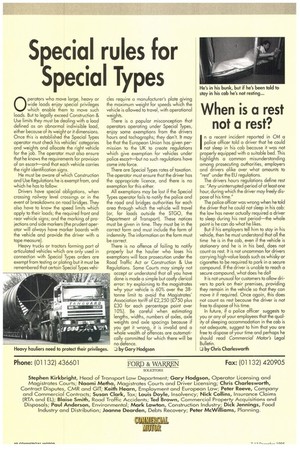Special rules for Special Types
Page 50

If you've noticed an error in this article please click here to report it so we can fix it.
0 perators who move large, heavy or wide loads enjoy special privileges which enable them to move such loads. But to legally exceed Construction & Use limits they must be dealing with a load defined as an abnormal indivisible load, either because of its weight or it dimensions. Once this is established the Special Types operator must check his vehicles' categories and weights and allocate the right vehicle for the job. The operator must also ensure that he knows the requirements for provision of an escort—and that each vehicle carries the right identification signs.
He must be aware of which Construction and Use Regulations he is exempt from, and which he has to follow.
Drivers have special obligations, when crossing railway level crossings or in the event of breakdowns on road bridges. They also have to know the speed limits which apply to their loads; the required front and rear vehicle signs; and the marking of projections and side markers (the prudent operator will always have marker boards with the vehicle and provide the driver with a tape measure).
Heavy trucks or tractors forming part of articulated vehicles which are only used in connection with Special Types orders are exempt from testing or plating but it must be remembered that certain Special Types vehi
cles require a manufacturer's plate giving the maximum weight for speeds which the vehicle is allowed to travel, with operational weights. There is a popular misconception that operators operating under Special Types, enjoy some exemptions from the drivers hours and tachographs; they don't. It may be that the European Union has given permission to the UK to create regulations which give exemption for vehicles under police escort—but no such regulations have come into force.
There are Special Types rates of taxation. The operator must ensure that the driver has the appropriate licence, and there is no exemption for this either. All exemptions may be lost if the Special Types operator fails to notify the police and the road and bridges authorities for each area through which the vehicle will travel (or, for loads outside the STGO, the Department of Transport). These notices must be given in time. They must be in the correct form and must include the form of indemnity. The information on the form must be correct.
There is no offence of failing to notify properly but the haulier who loses his exemptions will face prosecution under the Road Traffic Act or Construction & Use Regulations. Some Courts may simply not accept or understand that all you have done is made a simple but costly clerical error: try explaining to the magistrates why your vehicle is 60% over the 38tonne limit to avoid the Magistrates' Association tariff of £2,250 (£750 plus 230 for each percentage point over 10%). Be careful when estimating lengths, widths, numbers of axles, axle weights and axle spacings because if you get it wrong, it is invalid and a whole wealth of offences are automatically committed for which there will be no defence.
D by Gary Hodgson












































































































